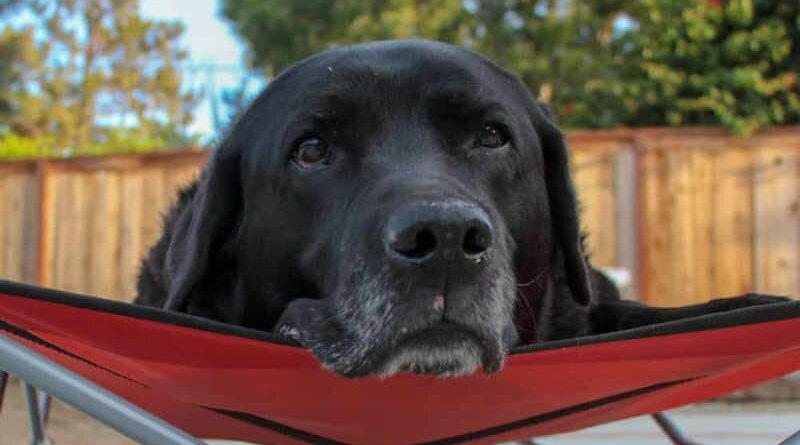You Can Teach an Old Dog New Tricks!
This post may contain affiliate links. We may earn money or products from the companies mentioned in this post.
Is the old saying that “you can’t teach an old dog new tricks” true? No! Old dogs can learn new behaviors.
They may have some physical or cognitive limitations you need to take into account. But most older dogs love to learn new things.
I’ve rescued some adult and senior dogs and they loved the attention–and treats–when I taught them new behaviors.
One of my rescues, a sheltie named Lady, didn’t even know how to sit on cue when I adopted her. She was about seven or eight years old when rescued.
She had been in at least three other placements and knew her name, but that was about it.
One of the first commands most people teach their dogs is to sit. New puppy parents are usually so proud when their puppy learns to sit on cue.
Sadly, no one gave Lady any attention when she was young apparently.
Lady was the sweetest dog. She loved everyone–and was in heaven when she was petted and told what a good girl she was.
Rescued sheltie Lady paying attention
After she settled in, we started training. She was a quick study.
It was so cute when she learned to sit on cue. She didn’t lure back, so I captured the behavior and rewarded it.
She looked at me as if to say: ”I’ve been doing this all my life. I didn’t know I could get a treat for sitting!”
Lady sitting on cue
Within less than a year of her arrival, Lady learned all 10 exercises to pass the AKC’s Canine Good Citizen test!
Some of the tests involved sit and down stay, loose leash walking, come, calmly greeting people and dogs, and more.
She even learned tricks and became a therapy dog who accompanied me to a hospital to comfort patients. Lady beamed with pride.
Why Teach an Old Dog New Tricks?
There are many reasons to teach an adult or senior dog new behaviors.
If you’ve just rescued the dog, you may need to teach him even some basic things such as house training. Or if you’ve had the dog for years, he still should keep learning. Reasons include:
- Teaching a new dog important behaviors. If a dog is new to you, he may need to learn even basic behaviors such as house training and his name. And many other cues, such as paying attention, sit/down/stay, come, leave it, and how to walk on a loose leash.
- Promoting physical health. Teaching obedience cues and tricks can help your dog remain physically healthy. Depending on the dog’s ability, the trick can involve some physical exertion. And stretching and moving can help rejuvenate a dog and keep his weight down.
- Preventing cognitive decline and boredom. An older dog is more likely to suffer from cognitive decline. So giving him something fun and challenging to do can help stimulate his mind. And it will also help prevent him from being bored, just lying around.
- Preparing for a new experience. You may need to train your older dog when he will be experiencing something new, such as traveling, walking on a leash in a more crowded area, or becoming accustomed to a new house.
- Furthering your bond. Obviously, you love your dog or you wouldn’t be reading this blog post. But whether you have a new dog or a long-time best bud, training can serve to further your bond. After all, dogs love to be with their pet parents–and the praise and rewards they get while learning.
So there are many reasons to teach your older dog some new obedience cues or behaviors.
Limitations To Take Into Account When Training an Older Dog
What you can or should teach the dog depends on many factors. You need to take into account his physical and mental health.
Older dogs may suffer from joint pain or degeneration, arthitis, vision or hearing loss, or a decline in cognitive function.
So have a full vet check-up before beginning a new training program.
And ask your vet about any limitations your dog may have so that you can choose the right tricks for his abilities and needs.
Your vet may even recommend a physical therapist for your pup if he needs it for certain physical exercises. Or may even show you how to have your dog stretch prior to them.
If your dog has cognitive decline, ask about what your dog’s limitations–and abilities–are. The same is true of hearing or vision deficits.
You should also have his teeth checked, as older dogs tend to have dental issues, which may affect his abilities to do some tricks such as retrieving.
When my senior rescue shih tzu Trevor was losing his vision, we still played scent-work type games.
I would toss some kibble and treats down. And he would happily sniff them out and scarf them down. The game really perked up his spirits.
Trevor relaxing
After all, he was used to being active. When Trevor was younger, he was a therapy dog who loved the attention he received. And he used to go with me to class and was shown in obedience and rally.
But by his last few years, those activities were too strenuous for him. So he needed something to do or he would have been very bored and unhappy.
So he looked forward to playing “find it” and other games he was capable of participating in.
There are many ways to keep your dog entertained.
Factors To Consider When Training an Older Dog
Other than the previously mentioned physical and cognitive limitations your dog may have, remember that there are other matters to take into account when deciding on and implementing your training program.
How an Older Dog Learns
A 2016 study conducted by the University of Veterinary Medicine Vienna, Clever Dog Lab, found that dogs 10 and older took more than twice as long as puppies aged six months to a year old to learn new behaviors.
But it found that older dogs did retain behaviors that they knew. So the study found that dogs of all ages retained known behaviors.
The study didn’t find any correlation between dog breed and an aging dog’s ability to learn.
But remember that, according to experts such as Stanley Coren, different breeds are able to learn and retain information at different rates.
He rated some breeds as learning at faster rates and retaining information more readily. These included border collies, German shepherds, poodles, labrador and golden retrievers, rottweilers, and papillons.
Shih tzus and Lhasa apsos, two breeds that I’ve had for years, are near the bottom of his rankings.
I’ve trained many breeds and mixes over the years. And I pretty much agree with his rankings.
But we have to remember that dogs bred for a working purpose–such as herding, hunting, or protection–were bred to work with us and learn certain tasks.
And they generally learn more quickly than those bred for other purposes–such as being companions.
So my goldens, shelties, and Aussie mix learned obedience commands and tricks pretty quickly without a ton of repetitions.
And my shih tzus and Lhasa apsos took more repetitions and time to learn and retain information. So teaching “sit” may take five repetitions for the working breeds and maybe three times that for the shih tzu.
But my shih tzus and Lhasas did learn and retain even very complicated behaviors such as scent discrimination where she had to find a dumbbell I touched amongst others that I didn’t.
My shetties Amber, Duffy, and Murphy learned these pretty quickly and within weeks were pretty reliable.
Murphy demonstrating the sit cue
But my shih tzu China took months to become reliable in finding the right scented dumbbell–especially in new, distracting environments.
Have Patience
Of course dog training takes patience. And training an older dog can take more patience than training a younger one.
Older dogs can take two times longer to learn new behaviors than younger ones do.
So have plenty of time for your sessions. And appreciate your dog for who he is now.
Reward Desired Behaviors
Of course using positive reinforcement is the best way to train. Behaviors that are rewarded will generally be repeated.
But what is positive reinforcement really? It involves what your particular dog finds reinforcing. And this isn’t always treats.
Of course most dogs love receiving food rewards. But there are many other ways to reward your pup.
Praise, play, petting, and experiences he likes such as going on a walk or sniffing in your yard can all be used to reinforce your dog’s behavior.
I usually advise starting with treats and praise. Then you can also transition to other rewards.
As far as treats go, remember to count them into your dog’s daily calories. Older dogs are often less active and more prone to gaining weight.
When training my now-senior rescued golden retriever Riley, I do much shorter sessions than I used to do.
Riley sitting
We even used to do half-hour or longer sessions sometimes when he was younger and showing in obedience and rally competitions.
He was very energetic and loved learning new things–and making known commands more precise. My vet even called him “the wild child.”
Training gave him some impulse control. And he loves it and we bond.
Now, we may just do two exercises each training session for a few minutes total. I don’t want to wear him out or bore him.
Do Short, Consistent Sessions With Needed Breaks
Train every day if possible. But keep the sessions short. Take breaks.
Your dog will learn better if you do three short five-minute sessions than one long half-hour session. Most dogs learn better with short sessions.
Senior dogs will generally tire more easily (depending on breed and health) than younger ones.
So you may teach only one behavior per session at first. It may take a few weeks for him to consistently perform the new trick depending on its difficulty.
You want to keep your dog interested, not bored. And watch out for signs of exhaustion, including:
- Drooping his ears
- Yawning
- Excessive licking
- Boredom, such as looking away
- Sniffing the ground
You know your dog. So you’ll recognize his limitations. Just stop the session before he disengages.
What Training Exercises Are Best for an Older Dog?
What you can do will depend on your dog’s age and physical and cognitive limitations.
There are many basic and advanced behaviors that he can learn. You just need to know his limitations and abilities.
Some tricks that you may want to teach your pup are:
- The basics. If the dog is new to you or if he doesn’t know basic cues, start there. Teach him to sit, lie down, stay, come, loose leash walking, look, and leave it.
- Hand signals. Teaching hand signals for behaviors is great if your dog isn’t visually impaired. And it will really help you communicate if your pup is hearing-impaired. There are some common hand signals you can use.
- Clicker training. Using a clicker to mark desired behaviors and tell your dog he performed correctly is a great training tool. Using the clicker is also a way to teach tricks to visually-impaired dogs.
- Touch. Nose targeting to your hand is a fun trick for most dogs to learn. If your dog is hand-shy or has impaired vision though, you don’t want to teach this.
- Find it. Most dogs love any type of nosework. After all, their sense of smell is highly developed. I always say that they have a “nose brain.”
You can toss about 10 treats and kibble down, scattered, and tell your dog to “find it.” Or you can hide some in the room and tell him to find them.
- Fetch. You can teach your pup to take a toy and retrieve it back to you. As long as your dog is physically able to do this, it can be great for his physical and mental enrichment. You must first teach him to take and hold the toy.
- Teach the names of his toys and to put them away. If your pup can retrieve, you can teach him the names of his toys. Then you can teach him to carry them to a toy box and drop them in, one at a time.
- Shake hands/high five. As long as your pup is physically able to do this, it’s a fun trick that you can show off to your friends.
- Kiss. You can teach your dog to kiss your hand or cheek as long as he doesn’t have any visual or aggressive issues. You can put a dab of plain peanut butter or cream cheese and have him lick it off, then add the cue “kiss.”
- Ring a bell. Whether you train him to ring a bell hanging from a doorknob or one on the floor or wall, this is a fun trick. You can teach your dog to target the bell with his nose or paw.
- Puzzle toys. Depending on what your dog can do, there are many toys to choose from. Snuffle mats are great for most dogs. You put kibble or dry treats in the nooks and crannies for your pup to find. It stimulates his natural foraging instincts and nose brain. Others encourage him to roll the toy or pull or push parts to find the hidden food treasures.
- Place. You can teach your pup to go to a bed or mat on cue.
- Spin. As long as he’s able, you can teach your pup to go around in a circle.
- Speak and quiet. You can teach your dog to speak and be quiet on cue.
- Count. After your pup learns to speak and be quiet on cue, you can teach him to “count” by giving a cue when to stop speaking.
The methods to teach your pup the above cues are found in my article on 21 dog training commands.
If your dog has a visual or hearing impairment, there are special techniques for training dogs with those issues.
For dogs who are deaf or going deaf, you can use hand signals and other methods. And for dogs with vision problems, there are special techniques too.
Even though all my dogs know basic and advanced obedience cues, there’s always a new trick to teach them.
I just taught my golden Riley to nod his head up and down when I ask him if something is the truth. It’s a funny trick that amuses friends.
I taught it by luring his head up and down three times with a yummy treat, praising and giving him the treat at the end.
Then I added the cue “truth” after he was used to that motion with his head.
So the sky’s the limit depending on what your dog can do.
FAQs
I just rescued an older dog who doesn’t really know and commands. He’s healthy. But can he still learn?
Yes! You can teach an old dog new tricks! Start with the basics. Teach him his name, to pay attention, sit, down, stay, and to walk on a loose leash. Start slowly–one cue at a time.
My old dog is losing his hearing and can’t hear me give commands he already knows like sit or come. What can I do?
You can teach him to look at you and add hand signals. Then, you can even teach him some fun tricks.
My older dog is losing his sight and can’t fetch any more. Is there any trick I can teach him to keep him happy and busy?
Yes! As long as he has the cognitive and physical ability, you can teach him many tricks and provide some enrichment activities for him.
You can lure him with a treat into a circle to spin. And you can teach him a “find it” cue when you toss some treats nearby so that he can sniff them out. And add puzzle toys to his repertoire to keep his mind and body active.
Final Thoughts
You can teach an old dog new tricks. You may have to modify how you train it or skip some because of his physical or cognitive abilities. But most older dogs can still learn. And he will have so much fun and bonding time with you.
Do you have or have you had an older dog that you taught tricks to?
Please tell us about it in the comments section below.
Save To Pinterest
Top Picks For Our Puppies
- BEST PUPPY TOY
We Like: Calmeroos Puppy Toy w/ Heartbeat and Heat Packs – Perfect for new puppies. Helps ease anxiety in their new home. - BEST DOG CHEW
We Like: Mighty Paw Naturals Bully Sticks – All of our puppies love to bite, nip, and chew. We love using Bully Sticks to help divert these unwanted behaviors. - BEST DOG TREATS
We Like: Crazy Dog Train-Me Treats – We use these as our high-value treats for our guide dog puppies. - BEST FRESH DOG FOOD
We Like: The Farmer’s Dog – A couple months ago we started feeding Raven fresh dog food and she loves it! Get 50% off your first order of The Farmer’s Dog.
Check out more of our favorites on our New Puppy Checklist.




